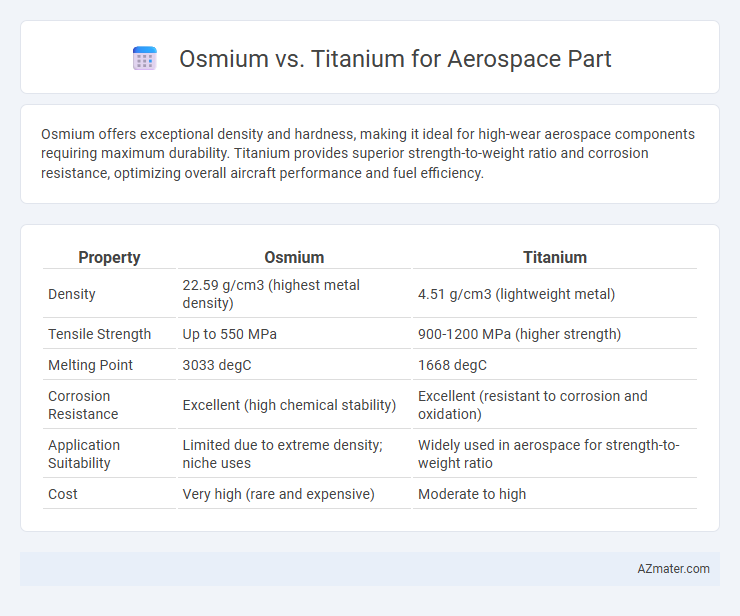Osmium offers exceptional density and hardness, making it ideal for high-wear aerospace components requiring maximum durability. Titanium provides superior strength-to-weight ratio and corrosion resistance, optimizing overall aircraft performance and fuel efficiency.
Table of Comparison
| Property | Osmium | Titanium |
|---|---|---|
| Density | 22.59 g/cm3 (highest metal density) | 4.51 g/cm3 (lightweight metal) |
| Tensile Strength | Up to 550 MPa | 900-1200 MPa (higher strength) |
| Melting Point | 3033 degC | 1668 degC |
| Corrosion Resistance | Excellent (high chemical stability) | Excellent (resistant to corrosion and oxidation) |
| Application Suitability | Limited due to extreme density; niche uses | Widely used in aerospace for strength-to-weight ratio |
| Cost | Very high (rare and expensive) | Moderate to high |
Introduction: Osmium vs Titanium in Aerospace Engineering
Osmium and titanium serve distinct roles in aerospace engineering due to their unique properties; titanium is prized for its high strength-to-weight ratio and corrosion resistance, making it ideal for structural components and airframes. Osmium, with its exceptional density and hardness, offers potential in specialized applications requiring wear resistance and durability in extreme environments. Understanding the comparative benefits of osmium's robustness and titanium's lightweight characteristics informs material selection for optimizing aerospace part performance.
Material Properties: Density and Weight Comparisons
Osmium's density at approximately 22.59 g/cm3 makes it one of the densest elements, significantly heavier than titanium, which has a density around 4.5 g/cm3, resulting in a weight difference critical for aerospace applications prioritizing weight reduction. Titanium's low density combined with its high strength-to-weight ratio offers superior performance for aerospace parts where minimizing mass affects fuel efficiency and payload capacity. Despite osmium's remarkable hardness and corrosion resistance, its extreme weight limits its practical use in aerospace components requiring lightweight materials.
Strength and Durability: Mechanical Performance
Osmium exhibits exceptional density and hardness, making it one of the strongest and most durable metals, ideal for applications requiring extreme wear resistance in aerospace parts. Titanium offers a superior strength-to-weight ratio and excellent corrosion resistance, crucial for aerospace components where weight reduction and mechanical performance are critical. While osmium provides unmatched hardness, titanium's combination of high tensile strength and low density ensures optimal durability and structural integrity in aerospace engineering.
Corrosion Resistance: Suitability in Aerospace Environments
Osmium exhibits exceptional corrosion resistance due to its dense, inert oxide layer, making it highly suitable for aerospace components exposed to extreme environments. Titanium also offers excellent corrosion resistance, particularly against oxidation and saltwater, which is critical for aerospace applications subjected to varying atmospheric conditions. The choice between osmium and titanium depends on balancing osmium's superior chemical stability with titanium's lighter weight and proven performance in aerospace structures.
Thermal Stability: High-Temperature Performance
Osmium exhibits exceptional thermal stability with a melting point of 3033degC, making it ideal for aerospace parts exposed to extreme high-temperature environments. Titanium, with a melting point of approximately 1668degC, offers good heat resistance but falls short compared to osmium in maintaining structural integrity at ultra-high temperatures. The superior high-temperature performance of osmium ensures enhanced durability and reliability in aerospace components subjected to intense thermal stress.
Machinability and Fabrication Efficiency
Osmium presents significant challenges in machinability due to its extreme hardness and brittleness, resulting in slower fabrication speeds and increased tool wear compared to titanium. Titanium alloys offer superior machinability with higher cutting speeds and better tool life, enhancing fabrication efficiency in aerospace manufacturing. The lighter weight and favorable mechanical properties of titanium further contribute to cost-effective and scalable production processes in aerospace applications.
Cost Analysis: Economic Implications for Aerospace Use
Osmium offers unmatched density and durability for aerospace parts but comes with significantly higher raw material and processing costs compared to titanium, which is favored for its cost-efficiency and lightweight properties. The economic implications of using osmium include increased manufacturing expenses and potential budget overruns, limiting its practical application to specialized components demanding extreme wear resistance. Titanium remains the economically viable choice for most aerospace applications, balancing performance with lower lifecycle costs and widespread availability.
Real-World Applications: Case Studies in Aerospace
Osmium's high density and corrosion resistance make it ideal for aerospace components requiring extreme wear resistance, such as vibration dampers and specialized bearings in spacecraft. Titanium's lightweight and excellent strength-to-weight ratio enable widespread use in aircraft frames, engine components, and fasteners, significantly improving fuel efficiency and structural integrity. Case studies from aerospace manufacturers reveal titanium's dominance due to cost-effectiveness and performance, whereas osmium is reserved for niche applications where maximum durability under harsh conditions is critical.
Environmental Impact and Sustainability
Osmium, being one of the densest and rarest metals, has a significantly higher environmental impact due to its intensive mining process and limited availability, which raises sustainability concerns in aerospace applications. Titanium, widely used in aerospace engineering, offers a more sustainable option because of its abundance, recyclability, and lower environmental footprint during extraction and processing. The preference for titanium over osmium in aerospace parts is driven by its balance of high strength-to-weight ratio and reduced ecological impact, supporting long-term sustainability goals in the industry.
Conclusion: Choosing the Optimal Material for Aerospace Parts
Osmium offers exceptional density and hardness, making it ideal for applications requiring extreme wear resistance and durability in aerospace parts. Titanium provides an excellent strength-to-weight ratio and corrosion resistance, crucial for lightweight structural components and fuel efficiency. Selecting between osmium and titanium depends on balancing the need for mechanical strength, weight constraints, and environmental resistance specific to aerospace design requirements.

Infographic: Osmium vs Titanium for Aerospace Part
 azmater.com
azmater.com